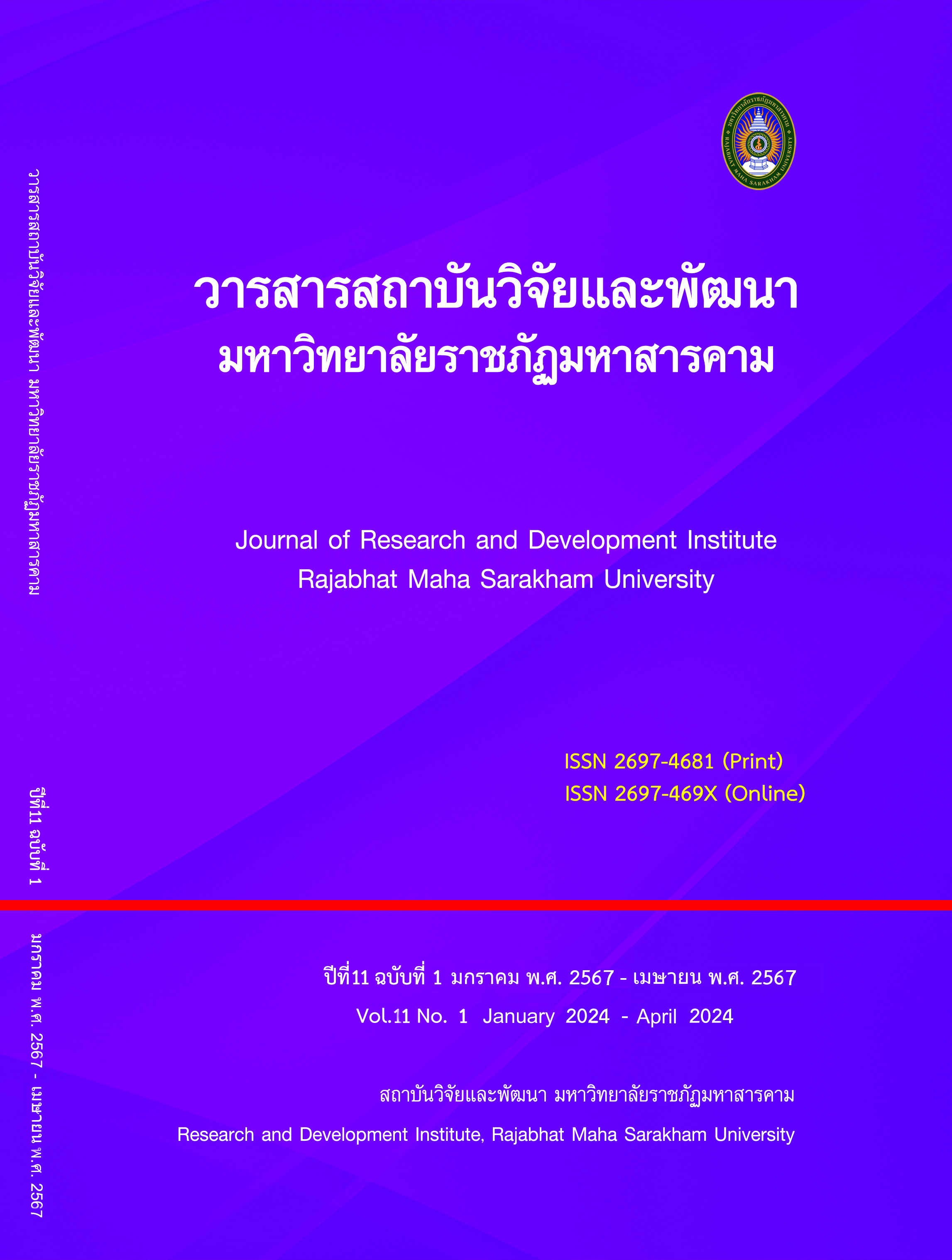การเปรียบเทียบความสามารถในการเขียนโปรแกรมเบื้องต้นและผลสัมฤทธิ์ทางการเรียน โดยการจัดการเรียนรู้แบบ 5 STEPs ร่วมกับสื่อมัลติมีเดีย สำหรับนักเรียนชั้นมัธยมศึกษาปีที่ 1
คำสำคัญ:
การจัดการเรียนรู้แบบ 5 STEPs, สื่อมัลติมีเดีย, ความสามารถในการเขียนโปรแกรมเบื้องต้นบทคัดย่อ
การวิจัยนี้มีวัตถุประสงค์เพื่อ 1) เปรียบเทียบความสามารถในการเขียนโปรแกรมเบื้องต้น โดยการจัดการเรียนรู้แบบ 5 STEPs ร่วมกับสื่อมัลติมีเดีย สำหรับนักเรียนชั้นมัธยมศึกษาปีที่ 1 หลังเรียนกับเกณฑ์คะแนนร้อยละ 70 2) เปรียบเทียบผลสัมฤทธิ์ทางการเรียนในการเขียนโปรแกรมเบื้องต้น โดยการจัดการเรียนรู้แบบ 5 STEPs ร่วมกับสื่อมัลติมีเดีย สำหรับนักเรียนชั้นมัธยมศึกษาปีที่ 1 หลังเรียนกับเกณฑ์คะแนนร้อยละ 70 กลุ่มเป้าหมาย ได้แก่ นักเรียนชั้นมัธยมศึกษาปีที่ 1 ภาคเรียนที่ 2 ปีการศึกษา 2565 จำนวน 22 คน ได้มาโดยการเลือกแบบเจาะจง ใช้รูปแบบการวิจัยแบบการทดลองกลุ่มเดียว (One-group posttest only design) เครื่องมือในการวิจัย 1) แผนการจัดการเรียนรู้แบบ 5 STEPs ร่วมกับสื่อมัลติมีเดีย จำนวน 12 แผน ใช้เวลา 12 ชั่วโมง 2) แบบทดสอบวัดความสามารถในการเขียนโปรแกรมเบื้องต้น เป็นข้อสอบอัตนัยแบบกำหนดเกณฑ์ (Rubric Score) จำนวน 8 ข้อ และ 3) แบบทดสอบวัดผลสัมฤทธิ์ทางการเรียน เป็นแบบปรนัยชนิดเลือกตอบ 4 ตัววเลือก จำนวน 30 ข้อ สถิติที่ใช้ในการวิเคราะห์ข้อมูล ได้แก่ ร้อยละ ค่าเฉลี่ย และ ส่วนเบี่ยงเบนมาตรฐาน
ผลวิจัยพบว่า
- ความสามารถในการเขียนโปรแกรมเบื้องต้น โดยการจัดการเรียนรู้แบบ 5 STEPs ร่วมกับสื่อมัลติมีเดีย สำหรับนักเรียนชั้นมัธยมศึกษาปีที่ 1 หลังเรียนสูงกว่าเกณฑ์ร้อยละ 70 อย่างมีนัยสำคัญทางสถิติที่ระดับ .01
- ผลสัมฤทธิ์ทางการเรียนในการเขียนโปรแกรมเบื้องต้น โดยการจัดการเรียนรู้แบบ 5 STEPs ร่วมกับสื่อมัลติมีเดีย สำหรับนักเรียนชั้นมัธยมศึกษาปีที่ 1 หลังเรียนสูงกว่าเกณฑ์ร้อยละ 70 อย่างมีนัยสำคัญทางสถิติที่ระดับ .01
References
Chookhampaeng, C. (2016). Curriculum Research and Development Concept and Process. Bangkok : Chulalongkorn University Press.
Institute of Academic Development (IAD). (2021). Active learning management towards creating innovation with advanced thinking processes using the GPAS 5 Steps system. Bangkok : Academic Quality Development (IAD) Company Limited.
Kanthiya, P. (2016). The Development of Analytical Thinking Skills for Science Through Five Steps Learning Management of Secondary School. Master of Education. Chiang Mai Rajabhat University.
National Strategy Secretariat Office, Office of the National Economic and Social Envelopment Board. (2018). National Strategy 2018-2037 . government gazette. Vol 135. episode 82 .
Prommuang, N. (2017). Development of basic spelling skills. with multimedia For Grade 1 students at Demonstration School Chiang Rai Rajabhat University, Mueang District, Chiang Rai Province. (Master of Arts Thesis). Chiang Rai: Chiang Rai Rajabhat University.
Office of the Education Council. (2021). Guideline for promoting teaching and learning in computational science (Coding) to develop learners’ skills in the 21st Century. Bangkok : 21 Century.
Office of the Education Council. (2017). The National education plan B.E. 2017-2036. Bangkok : Office of the Education Council.
Kongpila, O. (2021). The study of the development result of learning activities with the QSCCS process using social media to develop problem-solving skills of secondary school students M 5. Basic Education Research Journal. 1st Edition (July - December 2021)
Yingnok, P. (2021). The study of learning achievement and analytical thinking by using the 5 STEPs learning process with the cooperative learning method STAD technique of 10th grade students. The requirements for master of education in science teaching faculty of education. Burapha University.
Dechakupt, P. (2014). The effects of 5 steps learning process (5 steps). Bangkok : Chulalongkorn University Press.
Bueraheng, S. (2017). Using Harrow’s Instructional Model for Psychomotor Domain with Group Process on Computer Programming Competency of Matthayomsuksa 4 Students. Master of Education in Teaching Science Mathematics and Computer. Thaksin University.
Wanasiri, S. (2017). The Development of Learning Achievement on “The Universe” of Science Learning for Matthayomsuksa 3 students using 5E Inquiry Learning Management together with Multimedia. Master of Education (Curriculum and Instruction) Rajabhat Mahasarakham University.
Sengsri, S. & and Panna, W. (2018). The result of QSCCS learning process and learning resources in the community to promote the ability of mathematical for secondary student. Journal of Education Naresuan University Vol.20 No.4 October – December 2018.
The Institute for the Promotion of Teaching Science and Technology. (2017). Manual for using the technology curriculum (Computing Science) Learning Area of Science and Technology. Bangkok : Aksorn Charoen TAT A.C.T. (25) Company Limited.
Downloads
เผยแพร่แล้ว
How to Cite
ฉบับ
บท
License
Copyright (c) 2024 ชาญชัย สุริยบุญ, ดุจเดือน ไชยพิชิต

This work is licensed under a Creative Commons Attribution-NonCommercial-NoDerivatives 4.0 International License.
บทความที่ได้รับการตีพิมพ์เป็นลิขสิทธิ์เป็นของผู้ประพันธ์บทความ






